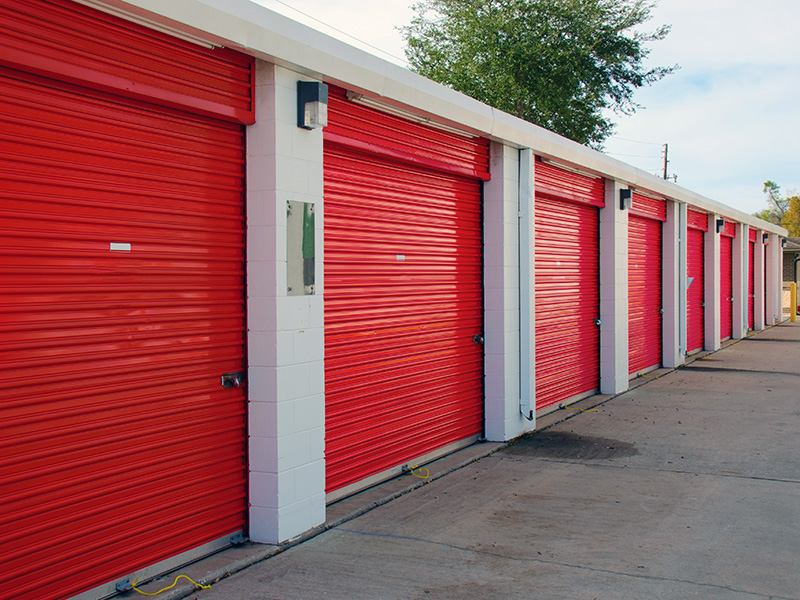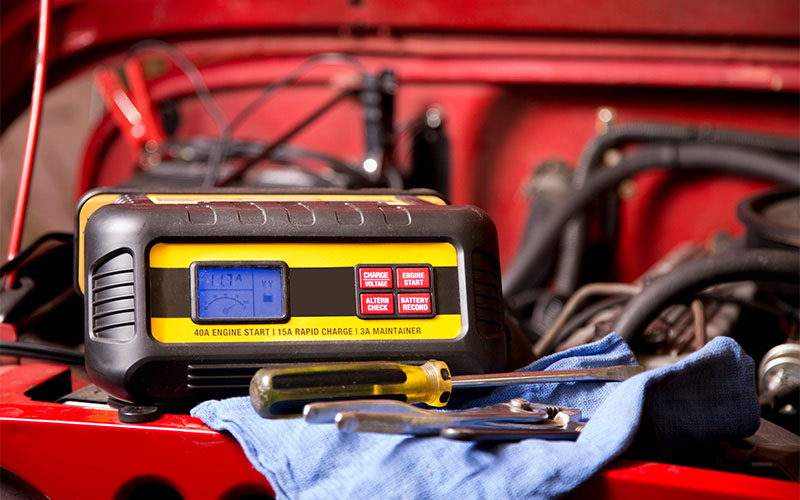At American Collectors Insurance, we don’t stop at offering great rates on great policies. Our TreasureGuard policy provides broader protection and greater flexibility. Receive a classic car insurance quote in minutes to see how you can save.

In a perfect world, classic car storage means that we would all have a “Garaj Mahal” to keep our favorite collector cars close at hand. But that’s not the case for a lot of automotive enthusiasts, many of whom are actively searching for classic car storage ideas. We put together some “do’s and dont’s” for you to consider when you’re making a plan to store your classic car.
Choosing the Right Place to Store Your Classic Car
If your local public storage provider has garages that fit your classic car, it’s probably not the worst idea to store with them, right? Unfortunately, there are a lot of risks that come along with using a traditional storage location for your classic car.

To begin you’ll want to read the fine print of the contract before you even consider storing with a general-purpose facility. Many storage providers have a maximum permitted value for everything you have in the unit – and that value is sometimes as low as $5,000. Storing a vehicle with a value over the maximum can cause you hassles ranging from difficulties with a damage claim to an outright breach-of-contract situation where you might have to come get your car on very short notice, whether you’re ready to do that or not.
But even once you’ve verified that you’re clear to store your classic car at a public facility, your worries are far from over. Who provides the lock, and how secure are those locks? How is access to the facility handled? Unless your needs are unusual, you should strongly consider a facility that limits access to the daylight hours. It’s also worth discussing general security procedures. Is the facility verified empty at the end of every day, or is it possible for someone to spend all night drilling out your locks and figuring out how to steal your car?
You should also be aware that your insurance company will need to be notified of your storage location – and don’t be surprised if they adjust your rate accordingly. Even the best general storage facilities are not as secure as the average home. Failing to do this can lead to some tough conversations with your insurer if your classic car is stolen or vandalized.
It is also important to consider the storage unit itself. How well-secured is it from access via the units around it? Is there a camera facing the unit – and will the storage provider give you the footage if something happens? As strange as it sounds, many general storage facilities won’t share any video footage, even if you filed a police report.
While it’s unpleasant to have roaches and other bugs in your storage unit, they’re not nearly as bad as mice. Rodents can make havoc of classic-car wiring. One trick to try: before you actually take your car over to the storage unit, try leaving a spare wiring harness on the ground for a few weeks, then evaluate it. If something’s been chewing on it – well, you can expect more of that to happen. Even without any obvious signs of mice or rats in the unit, it never hurts to put out a few mouse traps and check them periodically. If you see one mouse, assume there are fifty more where he came from.
Given all the hassles and uncertainties discussed above, it’s no surprise that many collectors choose a storage provider specifically tailored to classic or collector cars. The number of these facilities is growing rapidly, particularly along the coasts. You can expect much better security, cleanliness, and attention to detail at these facilities – but that doesn’t mean you shouldn’t do a bit of due diligence before dropping your car off for the winter.
In particular, you’ll want to know how frequently your car will be driven or moved. If your storage provider uses “stacker” storage, and your car is at the bottom of that stacker, then it will be started and moved any time the owners above you want access to their cars. If you happen to share space with a weekend-warrior sports-car owner, that can be a few dozen extra cold starts a year – which in 6-volt cars or older cars can lead to a dead battery in a hurry.
You should also get a sense of how and when your car will be evaluated for damage, and what happens if you discover damage that may have been done by the storage facility. This can turn into “he-said, she-said” in a hurry. Full camera coverage in the storage unit can go a long way towards answering these kinds of questions. Last but not least, you should be aware of the services that are offered – and are not offered – by your storage provider, ranging from detailing to winterization and small repair tasks. Will your garage keep air in your tires? If not, how easy will it be for you to do it locally?
The Alternative: Additional Storage of Your Own
If you have the space, zoning, and ability to put up your own storage space on your property, you’ll be surprised how quickly it “pays for itself” compared to dedicated classic-car storage. There are multiple providers of high-quality steel storage buildings that can be put up (carefully) by two people. If your municipality prevents a steel shed, you can look at the numerous prefab wooden buildings options out there. In either case the cost not be extravagant. In fact, you are likely to find that the cost of putting in a concrete floor exceeds the cost of the building. You would want to do that if you can afford it, for reasons we’ll discuss in a little bit.

Best Practices for Storing a Classic Car
So, you’ve found a place, whether it’s in a general purpose storage facility, a classic-car specialist, or on your own property. What’s next?
Preparing Classic Car for Storage
In most cases, you should start with a thorough detail job, inside and out, paying particular attention to leather and vinyl surfaces. Confirm that the oil is in outstanding condition, as this can be a cause of internal corrosion if it’s not. Fill the fuel tank and add a stabilizing agent. Overinflate the tires by a few psi. If your tires are subject to flat-spotting, consider the use of “tire cradles” to help keep them round. And you’ll want at least one chock for the vehicle, so you can leave the parking brake off.
Putting a cover on a car that is already in storage seems like overkill, but it’s not. Indoor storage spaces are notorious for dirt and dust, some of which can be actively corrosive to your car’s finish. There’s also always a chance of animal damage to the paint. The good news is that you shouldn’t need a multi-layer car cover like the ones you’d use for outdoor storage.
If your storage unit does not have a hard concrete floor, you should strongly consider putting a polyurethane tarp beneath your vehicle. This will help prevent moisture from coming out of the ground and rusting the underside, suspension, and fuel tank of your car.
Faced with all these tasks, some classic-car collectors decide to go all the way to a “car bubble.” It’s not a bad idea; a high-quality classic car bubble can go a long way towards preventing the vast majority of storage-related issues. And they are filtered so dust, insects, and animals don’t get in along with the air.
Car bubbles aren’t the answer for everyone. To begin with, you’ll need continuous 110v power to the fan. And most bubbles won’t deter a mouse or rat from chewing its way into your classic car. Nor are the fans immortal, so if you have no plans to see your car at all for year, you might want to think about another method. (You could always put a cover on beneath the bubble, if you’re concerned.)
Other “prep steps” that are worth considering: disconnecting or (better yet) removing the battery, covering the tailpipe and air intake, and taking the stereo head unit home with you. It almost goes without saying that you shouldn’t use your classic car to store other valuables – but people do, including coin collections and jewelry!

Should You Start Your Classic Car Periodically?
The answer to this question is tougher than most people think. If you’re storing a two-year-old Honda, then yes – start it and run it for twenty minutes as often as you can. A car from the brass era, or a rare racer? Then it gets complicated.
Most experts agree that your “cycle” should go something like this:
- Start the car and let all fluids reach operating temperature
- Operate the HVAC in all settings for a while, if applicable
- Operate the transmission and move the car slightly to prevent flat-spotting
- Confirm that the battery is charging properly
- Shut down and seal the car back up
That being said, there are a lot of delicate classic cars for which the above routine will do nothing but add wear. Imagine you have a vintage race car that can run 30 hours between engine rebuilds. Do you want to burn 3 hours of that every winter? The majority of classic cars from the Fifties and forward, however, do benefit from being run periodically.
What Else Should I Consider?
If you’ve been thoughtful about the above issues, and you understand your car reasonably well, there is no reason you can’t enjoy years of trouble-free storage. When in doubt, however, you should consult an expert. In particular, you shouldn’t just try to “get home” at the end of your storage season if your car isn’t running well. Have it towed to your garage and shop. Everyone knows the story of the car that “ran when parked”, and it usually ends with serious mechanical damage. There’s only so much you can diagnose and repair in a storage unit.
One last thing: if you’re going to sell your classic car out of storage, it’s never a bad idea to fire it up and meet potential buyers somewhere else. It will give your a car a chance to get some exercise, and it can prevent giving potential thieves a leg up.
Storing a classic car isn’t always easy, and there are plenty of pitfalls – but a lot of owners say that the joy they get from taking their car out of storage periodically is like buying it all over again. Which isn’t a bad feeling at all!

Leave A Comment